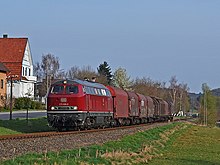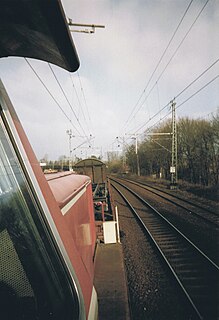
A train is a form of transport consisting of a series of connected vehicles that generally runs along a rail track to transport cargo or passengers. The word "train" comes from the Old French trahiner, derived from the Latin trahere meaning "to pull" or "to draw".

Surbiton railway station is a National Rail station in Surbiton, south-west London, in the Royal Borough of Kingston upon Thames. The station is managed and served by South Western Railway, and is in Travelcard Zone 6. It is 12 miles 3 chains (19.4 km) from London Waterloo and is situated between Berrylands and Esher on the main line.

Bingley railway station serves the town of Bingley in West Yorkshire, England, and is 13.5 miles (21.7 km) away from Leeds and 5.5 miles (8.9 km) away from Bradford Forster Square on the Airedale line operated by Northern.
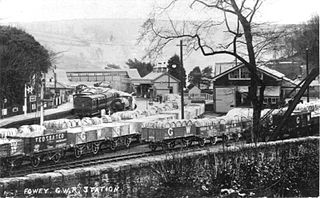
Fowey railway station was a station in Fowey, Cornwall on the Fowey to Newquay line. It was opened on 20 June 1876 when a passenger service was introduced on the line, which had been opened by the Cornwall Minerals Railway on 1 June 1874. The next station was Par.

Rollbocks, sometimes called transporter trailers, are pre-coupled narrow gauge transporter trucks or bogies that allow a coupled train of standard gauge wagons to be automatically loaded or rolled onto so that the train can then continue through a change of gauge.

A goods shed is a railway building designed for storing goods before or after carriage in a train. A typical goods shed will have a track running through it to allow goods wagons to be unloaded under cover, although sometimes they were built alongside a track with possibly just a canopy over the door. There will also be a door to move goods to or from road wagons and vans, this sometimes is parallel to the rail track, or sometimes on the side opposite the rail track. Inside the shed will generally be a platform and sometimes a small crane to allow easier loading and unloading of wagons.

A mixed train is a train that contains both passenger and freight cars or wagons. In the early days of railways they were quite common, but by the 20th century they were largely confined to branch lines with little traffic. Because mixed trains involve the shunting of goods wagons at stations along the way, they provide passengers with a very slow service, and have largely disappeared today. Their use is also at variance with the separation of passenger and goods services into different subsidiaries by most modern railway administrations.

The British Railway Clearing House (RCH) was an organisation set up to manage the allocation of revenue collected by pre-grouping railway companies of fares and charges paid for passengers and goods travelling over the lines of other companies.

Challow railway station is a former railway station about 2 miles (3 km) south of Stanford in the Vale on the A417 road between Wantage and Faringdon. It is named after the villages of West Challow and East Challow, which are 1.5 miles (2.4 km) and 2.5 miles (4 km) southeast of the former station.
Old Meldrum railway station was a railway station in Old Meldrum, Aberdeenshire.
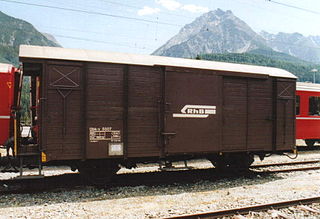
Goods wagons or freight wagons are unpowered railway vehicles that are used for the transportation of cargo. A variety of wagon types are in use to handle different types of goods, but all goods wagons in a regional network typically have standardized couplers and other fittings, such as hoses for air brakes, allowing different wagon types to be assembled into trains. For tracking and identification purposes, goods wagons are generally assigned a unique identifier, typically a UIC wagon number, or in North America, a company reporting mark plus a company specific serial number.

Open wagons form a large group of railway goods wagons designed primarily for the transportation of bulk goods that are not moisture-retentive and can usually be tipped, dumped or shovelled. The International Union of Railways (UIC) distinguishes between ordinary wagons and special wagons (F/6). Open wagons often form a significant part of a railway company's goods wagon fleet; for example, forming just under 40% of the Deutsche Bahn's total goods wagon stock in Germany.
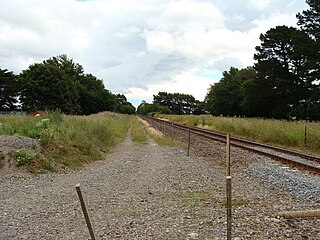
Clareville railway station was a flag station serving the small settlement of Clareville, north of Carterton in the Wairarapa region of New Zealand's North Island. It survived for nine decades from when it opened in 1880 until closure to all traffic in 1970.
The Tetbury branch line was a seven and a half mile long single track branch railway line that ran from Kemble railway station on the Great Western Railway's Golden Valley Line to Tetbury via five intermediate stations, Jackament's Bridge Halt, Rodmarton Platform, Church's Hill Halt, Culkerton Halt, and Trouble House Halt.

Kolkata railway station formerly known as Chitpur Station, is the newest of the five intercity railway stations serving Howrah and Kolkata, India; the others are Sealdah Station, in Kolkata, Shalimar Station in Howrah and Howrah Station in Howrah, Santragachi Junction railway station in Howrah. Kolkata station is situated in the Chitpur locality of north central Kolkata.

Milk trains were a common sight on the railways of Great Britain from the early 1930s to the late 1960s. Introduced to transport drinking milk from creameries to consumers in the cities, by 1981 they had all been replaced by road transport.
The Gandhidham–Samakhiali section is a rail line belonging to Western Railway of Kutch district in Gujarat state, India. It passes through Bhimasar Bg, Chirai Bg and Bhachau Bg.

The Tarka Valley Railway in Devon, England, is a proposed heritage railway based on plans to rebuild the Barnstaple to Halwill Junction railway line. So far only a short demonstration line has been set up, and planning permission was granted for 300 ft of track in the direction of Bideford. The railway has been fenced off from the Tarka Trail ensuring the safety of all involved. Restoration of various items of railway stock is currently under way.
